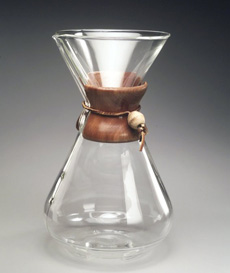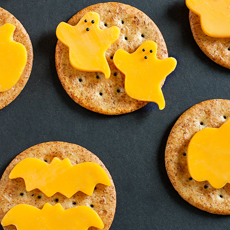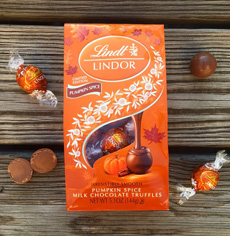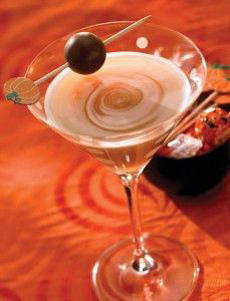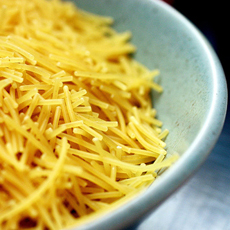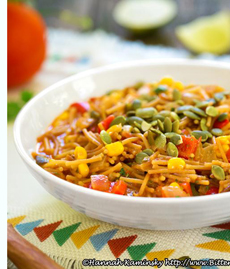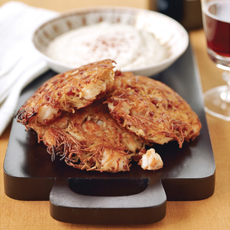
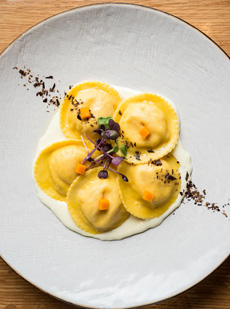


[1] Chef Eric Levine adds a ring of flavorful spices around a circle of salad. [2] At Obicà, a Neapolitan-focused restaurant, Chef Erind Halilaj adds a dramatic spice stripe over butternut squash ravioli. [3] They’re not spices, but crumbs, used here by Chef Daniel Eddy of Rebelle, are lovely garnishes. [4] Spice blends make tasty rimmers for cocktails, too (photo courtesy Pompeian). |
|
For festive occasions—or simply to dress up an everyday meal—make your plates sing with a scatter of spice.
Once upon a time, professional chefs and the home cooks who copied would use a piece of parsley or other green herb to garnish the plate. Since most foods fell into the brown-beige color family, the plate garnish would “give it some color.” Few people actually considered eating the parsley.
Today’s chefs are much more innovative. The paltry parsley has evolved into colored swaths of sauce, brushed onto plates; polka dots of sauce; drizzles of coulis; swirls of olive oil; condiments splattered like Jackson Pollack.
But the easiest way—no steady hand required—is to scatter herbs and spices onto the plate.
All you need to do is select flavors and colors that complement the food on the plate.
RECOMMENDED DRIED HERBS & SPICES FOR GARNISHING
This is not a comprehensive list; we went mostly for textured items rather than finely-ground powders. But you can use the latter if they work with your plate decorating concept.
Savory Dried Herbs & Spices
Black: black lava salt, nigella seeds, peppercorns (crushed/cracked), poppy seeds, toasted sesame seeds
Brown: allspice, caraway seeds, grains of paradise, nutmeg (crushed/cracked), smoked sea salt and other flavored gourmet salts, urfa biber
Green (pale): aniseed, fennel seeds, garam masala, green peppercorns, herbes de provence, lime peel, matcha salt, oregano, rosemary, za’atar
Green (deep): basil, chervil, cilantro, dill weed, epazote, fenugreek, fines herbs, matcha, parsley, tarragon
Orange: orange zest, shichimi togarashi (Japanese Seven-Spice)
Pink/Purple: Himalayan pink sea salt, lavender buds, Merlot sea salt, pink peppercorns, rose petals
Red: achiote, alaea red lava salt, aleppo or other chile flakes, annatto seeds, gochu garu (Korean chile flakes), piment d’espelette, sriracha salt and other red gourmet salts
Tan: celery seeds, Old Bay seasoning,
Yellow: aji amarillo powder, curry salt and other yellow flavored salts, fennel pollen, grapefruit zest, lemon zest, mustard seeds, turmeric
White: coarse sea salt (especially flake salt like Maldon or Cypress), flavored coarse white salt (garlic, lemon, lime) sesame seeds
More Savory Options
You may also have some of these in the cupboard:
Crumbs: bread crumbs, cracker crumbs, pretzel crumbs
Savory drink rimmers
Spice blends, from Italian herbs to shichimi togarashi, Japanese Seven Spice (don’t overlook Mrs. Dash)
Meat rubs
Smoked and flavored salts (for ideas see SeaSalt.com)
Sweet Dried Herbs & Spices
For desserts and other sweet dishes, consider:
Colored sugars: coarse sugar, decorating sugar, decorative sugar (shapes), sanding sugar, sparkling sugar
Conventional sugars: dark brown, demerara, light brown, muscovado, turbinado
Crumbs: cake crumbs, cookie crumbs
Flavored sugars: blueberry, cinnamon, espresso, green chile, raspberry, etc. (here’s the selection at EssentialCane.com, plus how to make your own)
Sweet herbs: basil, chervil, lemon thyme, garam masala, marjoram, mint, pink peppercorns, rosemary, sage, sweet cicely, tarragon
|
|
Sweet spice blends: apple pie spice, chai spice, mulling spice, pumpkin pie spice
Sweet spices:
+Black, brown and tan: allspice, anise seed, brown sugar (dark, light, raw, turbinado, cacao nibs, cardamom, cassia buds, chia seeds, cinnamon (crushed sticks), coffee beans (crushed), cloves (whole or crushed), nutmeg (freshly ground), poppy seed, vanilla bean pod (crushed)
+Green: lime peel or zest, matcha powder
+Pink and purple: dried rose petals (crumbled), lavender buds
+Yellow and gold: bee pollen, ginger (crystallized or cracked), granulated honey, peel or zest (grapefruit, lemon, orange)
+White: sesame seeds
MORE HERB & SPICE TIPS
Don’t toss “end of the bottle” spices and herbs to make room for new bottles. Instead, combine them in an empty bottle to create your own “garnishing blend.”
If an herb or spice has lost its flavor, you can still use it for garnish. In fact, it’s a great use for past-their-prime seasonings.
If you don’t like a spice you’re purchased, use it for a plate garnish. Some people don’t even attempt to taste the spices; and those who do dip a fork in it may like it.
WANT TO ADD A DRIZZLE?
If your plate could still use some filler, match one of these to the food. Note that the oil (or any liquid) should be placed on the plate first, before the food and the garnish.
Flavored oils: from basil and blood orange to habanero and wasabi.
Colored oils: naturally colored oils include avocado oil (virgin), hot chile oil*, dark sesame oil* and mustard oil*; you also can make your own colored oils).
Olive oil—for artistic purposes, the darker the better. You can add green food color—which is what more than a few bottlers [illegally] do.
Syrups: agave, dessert syrup, flavored simple syrup, honey, maple syrup, molasses.
________________
*These oils can be very strong, and may have to be diluted with olive oil or plated in droplets.
|
|
